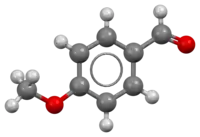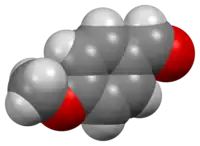4-Anisaldehyde
4-Anisaldehyde, or p-Anisaldehyde, is an organic compound with the formula CH3OC6H4CHO. The molecule consists of a benzene ring with an formyl and a methoxy group. It is a colorless liquid with a strong aroma. It provides sweet, floral and strong aniseed odor. Two isomers of 4-anisaldehyde are known, ortho-anisaldehyde and meta-anisaldehyde. They are less commonly encountered.
 | |||
| |||
| Names | |||
|---|---|---|---|
| Preferred IUPAC name
4-Methoxybenzaldehyde | |||
| Systematic IUPAC name
4-Methoxybenzenecarbaldehyde | |||
Other names
| |||
| Identifiers | |||
3D model (JSmol) |
|||
| ChEBI | |||
| ChEMBL | |||
| ChemSpider | |||
| ECHA InfoCard | 100.004.185 | ||
| EC Number |
| ||
| KEGG | |||
PubChem CID |
|||
| UNII | |||
CompTox Dashboard (EPA) |
|||
| |||
| |||
| Properties | |||
| C8H8O2 | |||
| Molar mass | 136.150 g·mol−1 | ||
| Density | 1.119 g/cm3[2] | ||
| Melting point | −1 °C (30 °F; 272 K)[2] | ||
| Boiling point | 248 °C (478 °F; 521 K)[2] | ||
| Hazards | |||
| GHS pictograms |  | ||
| GHS Signal word | Warning | ||
| H302 | |||
| P264, P270, P301+312, P330, P501 | |||
| Flash point | 108 °C (226 °F; 381 K) | ||
Except where otherwise noted, data are given for materials in their standard state (at 25 °C [77 °F], 100 kPa). | |||
| Infobox references | |||
Production
Anisaldehyde is prepared commercially by oxidation of 4-methoxytoluene (p-cresyl methyl ether) using manganese dioxide to convert a methyl group to the aldehyde group. It can also be produced by oxidation of anethole, a related fragrance that is found in some alcoholic beverages, by oxidative cleavage of an alkene.[3]
Uses
Being structurally related to vanillin, 4-anisaldehyde is a widely used in the fragrance and flavor industry.[3] It is used as an intermediate in the synthesis of other compounds important in pharmaceuticals and perfumery. The related ortho isomer has a scent of licorice.
A solution of para-anisaldehyde in acid and ethanol is a useful stain in thin layer chromatography.[4] Different chemical compounds on the plate can give different colors, allowing easy distinction.
References
- Merck Index, 11th Edition, 693
- "p-Anisaldehyde". Sigma-Aldrich.
- Karl-Georg Fahlbusch; Franz-Josef Hammerschmidt; Johannes Panten; Wilhelm Pickenhagen; Dietmar Schatkowski; Kurt Bauer; Dorothea Garbe; Horst Surburg (2003). "Flavors and Fragrances". Ullmann's Encyclopedia of Industrial Chemistry. Weinheim: Wiley-VCH. doi:10.1002/14356007.a11_141.
- Stains for Developing TLC Plates

